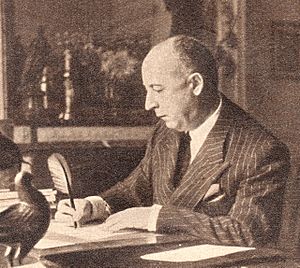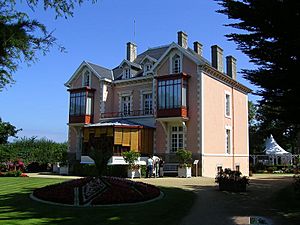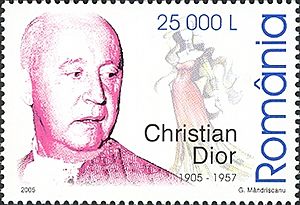Christian Dior facts for kids
Quick facts for kids
Christian Dior
|
|
|---|---|

Dior in 1954
|
|
| Born | 21 January 1905 Granville, France
|
| Died | 24 October 1957 (aged 52) Montecatini Terme, Tuscany, Italy
|
| Resting place | Cimetière de Callian, Provence-Alpes-Côte d'Azur, France |
| Alma mater | Sciences Po |
|
Label(s)
|
Christian Dior |
| Parents |
|
| Relatives |
|
Christian Ernest Dior (French: [kʁistjɑ̃ djɔʁ]; 21 January 1905 – 24 October 1957) was a French fashion designer, best known as the founder of one of the world's top fashion houses, Christian Dior SE, which is now owned by parent company LVMH. His fashion houses are known all around the world, specifically "on five continents in only a decade" (Sauer). He was the second child of a family of seven, born to Maurice Dior and Madeleine Martin, in the town of Granville.
Dior's artistic skills led to his employment and design for various well-known fashion icons in attempts to preserve the fashion industry during World War II. Post-war, he founded and established the Dior fashion house, with his collection of the "New Look" revolutionising women's dress and contributing to the reestablishment of Paris as the centre of the fashion world.
Throughout his lifetime, he won numerous awards for Best Costume Design. Upon his death in 1957, various contemporary icons paid tribute to his life and work.
Early life

Christian Dior was born in Granville, a seaside town on the coast of Normandy, France. He was the second of five children born to Maurice Dior, a wealthy fertilizer manufacturer (the family firm was Dior Frères), and his wife, formerly Madeleine Martin. He had four siblings: Raymond (father of Françoise Dior), Jacqueline, Bernard, and Catherine Dior. When Christian was about five years old, the family moved to Paris, but still returned to the Normandy coast for summer holidays.
Dior's family had hoped he would become a diplomat, but Dior was artistic and wished to be involved in art. To make money, he sold his fashion sketches outside his house for about 10 cents each. In 1928, Dior left school and received money from his father to finance a small art gallery, where he and a friend sold art by the likes of Pablo Picasso. The gallery was closed three years later, following the deaths of Dior's mother and brother, as well as financial trouble during the Great Depression that resulted in his father losing control of the family business.
From 1937, Dior was employed by the fashion designer Robert Piguet, who gave him the opportunity to design for three Piguet collections. Dior would later say that "Robert Piguet taught me the virtues of simplicity through which true elegance must come." One of his original designs for Piguet, a day dress with a short, full skirt called "Cafe Anglais", was particularly well received. Whilst at Piguet, Dior worked alongside Pierre Balmain, and was succeeded as house designer by Marc Bohan – who would, in 1960, become head of design for Christian Dior Paris. Dior left Piguet when he was called up for military service.
In 1942, when Dior left the army, he joined the fashion house of Lucien Lelong, where he and Balmain were the primary designers. For the duration of World War II, Dior, as an employee of Lelong – who labored to preserve the French fashion industry during wartime for economic and artistic reasons - designed dresses for the wives of Nazi officers and French collaborators, as did other fashion houses that remained in business during the war, including Jean Patou, Jeanne Lanvin, and Nina Ricci. His sister, Catherine (1917–2008), served as a member of the French Resistance, was captured by the Gestapo, and sent to the Ravensbrück concentration camp, where she was incarcerated until her liberation in May 1945. In 1947, he named his debut fragrance, Miss Dior in tribute to his sister.
The Dior fashion house

The famous "Bar Suit" on display at the Denver Art Museum (2019).
|
In 1946, Marcel Boussac, a successful entrepreneur known as the richest man in France, invited Dior to design for Philippe et Gaston, a Paris fashion house launched in 1925. Dior refused, wishing to make a fresh start under his own name rather than reviving an old brand. On 16 December 1946, with Boussac's backing, Dior founded his fashion house. The name of the line of his first collection, presented on 12 February 1947, was Corolle (literally the botanical term corolla or circlet of flower petals in English). The phrase New Look was coined for it by Carmel Snow, the editor-in-chief of Harper's Bazaar.
Despite being called "New", it was clearly drawn from styles of the Edwardian era. The New Look merely refined and crystallized trends in skirt shape and waistline that had been burgeoning in high fashion since the late 1930s. Dior's designs were more voluptuous than the boxy, fabric-conserving shapes of the recent World War II styles, influenced by the wartime rationing of fabric.
Dior was a master at creating shapes and silhouettes. Dior was quoted as saying: "I have designed flower women." His look employed fabrics lined predominantly with percale, boned, bustier-style bodices, hip padding, wasp-waisted corsets, and petticoats that made his dresses flare out from the waist, giving his models a very curvaceous form.
Initially, women protested because his designs covered up their legs, which they had been unused to because of the previous limitations on fabric. Some of the backlash to Dior's designs was also due to the amount of fabric used in a single dress or suit. Gabrielle "Coco" Chanel said of the "New Look": "Look how ridiculous these women are, wearing clothes by a man who doesn't know women, never had one, and dreams of being one." During one photo shoot in a Paris market, the models were attacked by female vendors over this profligacy, but opposition ceased as the wartime shortages ended.
The "New Look" revolutionized women's dress and reestablished Paris as the centre of the fashion world after World War II, as well as making Dior a virtual arbiter of fashion for much of the following decade. Each season featuring a newly titled Dior "line", in the manner of 1947's "Corolle" line, that would then be trumpeted in the fashion press: the Envol and Cyclone/Zigzag lines in 1948; the Trompe l'Oeil and Mid-Century lines in 1949; the Vertical and Oblique lines in 1950; the Naturelle/Princesse and Longue lines in 1951; the Sinueuse and Profilėe lines in 1952; the Tulipe and Vivante lines in 1953; the Muguet/Lily of the Valley line and H-Line in 1954; the A-Line and Y-Line in 1955; the Flèche/Arrow and Aimant/Magnet lines in 1956; and the Libre/Free and Fuseau/Spindle lines in 1957, followed by successor Yves Saint Laurent's Trapeze line in 1958.
In 1955, the 19-year-old Yves Saint Laurent became Dior's design assistant. Christian Dior later met with Yves Saint Laurent's mother, Lucienne Mathieu-Saint Laurent, in 1957, to tell her that he had chosen Saint Laurent to succeed him at Dior. She indicated later that she had been confused by the remark, as Dior was only 52 at the time.
Death
Christian Dior died of a sudden heart attack while on vacation in Montecatini, Italy, on 24 October 1957 in the late afternoon while playing a game of cards. He was survived by Jacques Benita, a North African singer three decades his junior, the last of a number of discreet male lovers.
Awards and honors
Dior was nominated for the 1955 Academy Award for Best Costume Design in black and white for the Terminal Station directed by Vittorio De Sica (1953). Dior was also nominated in 1967 for a BAFTA for Best British Costume (Colour) for the Arabesque directed by Stanley Donen (1966). Nominated in 1986 for his contributions to the 1985 film, Bras de fer, he was up for Best Costume Design (Meilleurs costumes) during the 11th Cesar Awards.
See also
 In Spanish: Christian Dior para niños
In Spanish: Christian Dior para niños
- Château de La Colle Noire


